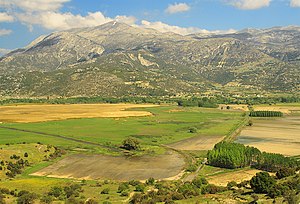Kyllini (mountain)
| Kyllini (Κυλλήνη) / Ziria (Ζήρια) | ||
|---|---|---|
|
Kyllini (Ziria) as seen from Lake Stymphalia |
||
| height | 2374 m ( Plakes ) | |
| location | Greece , Northern Peloponnese , Korinthia | |
| Mountains | Kyllini Mountains | |
| Coordinates | 37 ° 56 '30 " N , 22 ° 24' 0" E | |
|
|
||
Kyllini ( Greek Κυλλήνη ( f. Sg. ), Ancient Greek Kyllēnē , trans. Also Killini; also Ziria Ζήρεια ( f. Sg. )) Is the name of a mountain range in the north-northeast of the Greek peninsula Peloponnese in the prefecture of Korinthia . The highest elevation of the massif measures 2374 m, making it the second highest elevation on the peninsula after the Taygetos in Laconia .
geography
In the north of the Peloponnese, the Kyllini massif is the first large (over 2000 m peak) mountain massif west of the Isthmus of Corinth . The northern foothills of the massif extend to the Gulf of Corinth with the coastline from Kiato in the east to Akrata (west of Egira) in the west. The north-eastern eastern boundary of the Kyllini massif is the valley of the Krathis River , which rises in its course between the Aroania (Chelmos) in the west and the Kyllini in the east and flows into the Gulf of Corinth in a right-hand arc near Egira. Immediately to the east of the Kyllini summit, the mountain ranges merge into the neighboring Aroania massif to the west. Only a high level (level of Feneos ) with the road from Derveni on the coast to Lykoura and Spilia allow a separation of the two mountain ranges. To the west of this north-south running Feneos plateau is the small Doxis lake . The south-western limit is - besides the Feneos plateau - the northeastern foothills of the Dourdourvana (2103 m altitude). To the south, the Feneos plateau is closed by the northern foothills of the Oligyrtos (1934 m). The southeastern boundary of the Kyllini massif is formed by the plateau of Stymphalia and the Stymphalia lake contained therein. To the east and northeast, the Asopos river valley forms the boundary of the Kyllini massif.
The Kyllini massif has several peaks. In the north a spur rises to 1628 m height, in the east-northeast there is a spur with a height of 2086 m. Another foothill rises to the southwest at the Feneos plain at 1754 m. To the northwest rises a peak with 1793 m between the river valleys of Krathis in the west and Krios in the east.
Several rivers arise from the Kyllini massif, all of which flow into the Gulf of Corinth. The westernmost river is the Krathis . Further east, separated by a foothill of the Kyllini massif, runs the river Krios . At Derveni on the coast, the Zachpolitos (or Dervenios) flows into the Gulf of Corinth. Further east, the Fonissa river flows into the sea between Arachovitika and Kato Loutro. The largest river of the Kyllini massif is the Sythas , which flows from its origin on the north-northeast flank of the massif in a north-northeast direction to the sea, leaving a deep cut in the northeastern foothills of the Kyllini massif. The mouth of the Sythas lies between Xylokastro and Zevgolatio. The Asopos, which delimits the Kyllini massif to the east, flows east of Kiato into the Gulf of Corinth. In addition, three other rivers run in the area of the Kyllini massif. One of them runs through the plain of Feneos. Two others flow from the north and from the west into Lake Stymphalia, which, however, has no outflow by means of a river.
population
Due to the overall fertile areas (Stymphalia Plain, Feneos Plain) there were already two settlements in the area of the Kyllkini massif in ancient times: Stymphalos and Feneos . In ancient times, the Kyllini massif also described the border between the ancient landscapes of Achaia in the west and Arcadia in the east and south. According to the current administrative structure, this border no longer exists, as the Kyllini massif is completely part of the Korinthia prefecture, with the exception of the northwestern extension east of the Krathis.
The area of the Kyllini massif is sparsely populated in the prefecture of Korinthia compared to other regions (especially the agglomeration around the city of Corinth). Larger towns in the area of the Kyllini massif are Goura in the west and Kaliani in the east.
mythology
The name is said to come from a nymph of the same name , the mother of Lykaon ; according to another version, however, it was named after Kyllen, the son of Elatos . After the Greek mythology was the father Zeus in these mountains with Maia to Hermes , who was born in a cave and also his first acts accomplished - he found the turtle from whose tank he the first in Kyllene Mountains lyre anfertigte. In ancient times, there was a Hermes temple on the highest peak.

